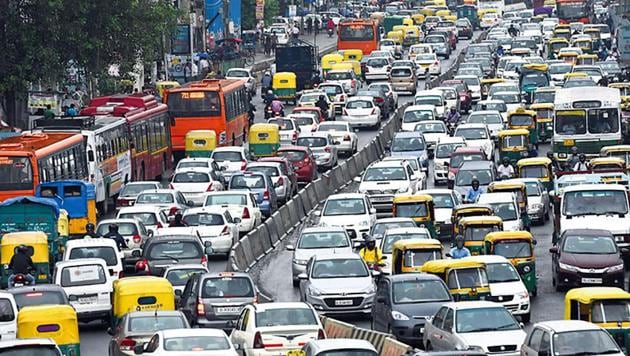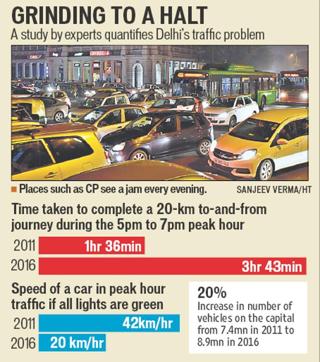Capital chaos: Delhi’s traffic has slowed down and doubled time spent on roads
The time spent by Delhiites on city roads has doubled in the last six years and the speed of traffic during peak hours has been cut by half, says a study by six top road design experts and engineers.
The time spent by Delhiites on city roads has doubled in the last six years and the speed of traffic during peak hours has been cut by half, says a study by six top road design experts and engineers.

Today, a person travelling a distance of 40 km by a private vehicle during peak hours spends an average of 3.43 hours on the road, as opposed to 1.36 hours in 2011.
On the other hand, the average speed of a vehicle being driven during the evening peak hours — between 5 pm and 7 pm — has come down from 42 kmph to 20 kmph (without taking traffic signals and other stoppages into account).
Experts say unless immediate steps are taken to unclog its roads, Delhi may find itself crawling at 5 kmph — the average speed of a human walking — in the next 10 years.
Interactive | These maps show you how you are losing the race against Delhi’s traffic

The increase in Delhi’s vehicular population, which is forcing its road network to burst at the seams, has been squarely blamed for this phenomenon. The number of vehicles on city roads has grown from 74 lakhs to 89 lakhs in the last six years, a jump of almost 20%. A further two lakh vehicles enter the city from outside every day, adding to the congestion.
The researchers, six Bhopal-based urban designers and road engineers hailing from premier institutes such as IIT Kharagpur, Delhi and BITS Pilani, will submit the study to the Delhi government next year.
They will also provide suggestions on ways to improve urban infrastructure and encourage the use of public transport.
The report has been sent to IIT Delhi for scrutiny by other transport experts.
To arrive at these findings, the experts assessed the travel time and average speed of vehicles on five routes linking residential neighbourhoods with corporate hubs over the last six years.
“The idea was to focus on how the rise in number of vehicles was not only adding to pollution levels but also eating up travel time. To confirm our findings, we tracked the same routes over the last six years to see how the traffic has started dragging due to the addition of more vehicles,” said Prashant Raju, a road design expert from IIT Kharagpur.
He said though the study is still in its primary stage, it exposes the manner in which people have exploited the city’s infrastructure. “If something is not done soon, the traffic situation here will become similar to that of Dhaka – where vehicles do not move any faster than 6 kmph during peak hours,” Raju cautioned.
Other transport experts agreed that the national capital’s traffic situation was fast headed towards a point of no return.
“If you keep filling a jar that’s already filled to the brim, it will overflow. That’s precisely the state of Delhi roads. The focus should be on encouraging people to use public transport by making it comfortable and easily accessible,” said Dr S Velmurugan, senior principal scientist at Council of Scientific and Industrial Research-Central Road Research Institute.
Delhi’s traffic has doubled in the last eight years, Velmurugan added.
Stay updated with all top Cities including, Bengaluru, Delhi, Mumbai and more across India. Stay informed on the latest happenings in World News along with Delhi Election 2025 and Delhi Election Result 2025 Live, New Delhi Election Result Live, Kalkaji Election Result Live at Hindustan Times.
Stay updated with all top Cities including, Bengaluru, Delhi, Mumbai and more across India. Stay informed on the latest happenings in World News along with Delhi Election 2025 and Delhi Election Result 2025 Live, New Delhi Election Result Live, Kalkaji Election Result Live at Hindustan Times.





